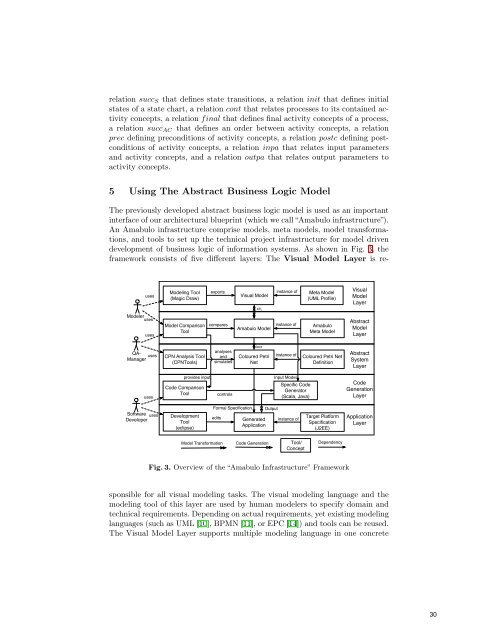A Framework for Integrating ESL Tools - IRIT
A Framework for Integrating ESL Tools - IRIT
A Framework for Integrating ESL Tools - IRIT
Create successful ePaper yourself
Turn your PDF publications into a flip-book with our unique Google optimized e-Paper software.
elation succ S that defines state transitions, a relation init that defines initial<br />
states of a state chart, a relation cont that relates processes to its contained activity<br />
concepts, a relation final that defines final activity concepts of a process,<br />
arelationsucc AC that defines an order between activity concepts, a relation<br />
prec defining preconditions of activity concepts, a relation postc defining postconditions<br />
of activity concepts, a relation inpa that relates input parameters<br />
and activity concepts, and a relation outpa that relates output parameters to<br />
activity concepts.<br />
5 Using The Abstract Business Logic Model<br />
The previously developed abstract business logic model is used as an important<br />
interface of our architectural blueprint (which we call “Amabulo infrastructure”).<br />
An Amabulo infrastructure comprise models, meta models, model trans<strong>for</strong>mations,<br />
and tools to set up the technical project infrastructure <strong>for</strong> model driven<br />
development of business logic of in<strong>for</strong>mation systems. As shown in Fig. 3, the<br />
framework consists of five different layers: The Visual Model Layer is re-<br />
uses<br />
Modeling Tool<br />
(Magic Draw)<br />
exports<br />
Visual Model<br />
instance of<br />
Meta Model<br />
(UML Profile)<br />
Visual<br />
Model<br />
Layer<br />
ATL<br />
Modeler<br />
uses<br />
uses<br />
Model Comparison<br />
Tool<br />
compares<br />
Amabulo Model<br />
instance of<br />
Amabulo<br />
Meta Model<br />
Abstract<br />
Model<br />
Layer<br />
QAuses<br />
Manager<br />
CPN Analysis Tool<br />
(CPN<strong>Tools</strong>)<br />
analyses<br />
and<br />
simulates<br />
Java<br />
Coloured Petri<br />
Net<br />
instance of<br />
Coloured Petri Net<br />
Definition<br />
Abstract<br />
System<br />
Layer<br />
uses<br />
provides input<br />
Code Comparison<br />
Tool<br />
controls<br />
Input Model<br />
Specific Code<br />
Generator<br />
(Scala, Java)<br />
Code<br />
Generation<br />
Layer<br />
Software uses<br />
Developer<br />
Development<br />
Tool<br />
(eclipse)<br />
Formal Specification<br />
edits<br />
Generated<br />
Application<br />
Output<br />
instance of<br />
Target Plat<strong>for</strong>m<br />
Specification<br />
(J2EE)<br />
Application<br />
Layer<br />
Model Trans<strong>for</strong>mation<br />
Code Generation<br />
Tool/<br />
Concept<br />
Dependency<br />
Fig. 3. Overview of the “Amabulo Infrastructure” <strong>Framework</strong><br />
sponsible <strong>for</strong> all visual modeling tasks. The visual modeling language and the<br />
modeling tool of this layer are used by human modelers to specify domain and<br />
technical requirements. Depending on actual requirements, yet existing modeling<br />
languages (such as UML [10], BPMN [11], or EPC [14]) and tools can be reused.<br />
The Visual Model Layer supports multiple modeling language in one concrete<br />
30

















